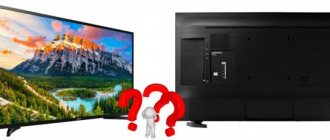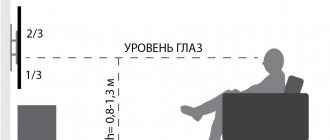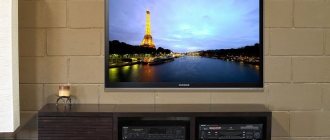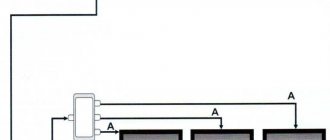15 Jul 2021
6060
Let's look at the main characteristics of TVs: diagonal, resolution, matrix type, screen refresh rate and additional functions. A complete overview of the parameters of modern TVs.
- How to choose the diagonal of the TV screen
- How to choose a resolution
- How to choose a matrix type
- How to determine screen refresh rate
- How to choose a sound
- What additional features might be useful?
- Summarize
Televisions today are not just devices for watching TV programs. These are smart gadgets that allow you to watch movies, TV series and streaming videos in high definition, play games, and access the Internet. If you want a new high-tech TV to replace an outdated one, you'll have to understand the technical specifications.
TV in the interior
How to choose the diagonal of the TV screen
The TV diagonal is the distance from the bottom left to the top right corner of the display. It is usually indicated in inches. The larger the diagonal, the greater its width and height. But a large screen diagonal does not always mean that the TV has good picture quality. Image quality depends on the resolution and matrix type.
Diagonal according to CNET standard
The distance from which you will watch TV affects the choice of device diagonal. The general rule of the CNET standard is that the larger the size, the farther audiences should sit. If a person sits too close to a large screen, he will not look at the entire screen; with a small diagonal, he will see a pixelated picture.
TV diagonals: 29–32 inches (81–100 cm), 40–43 inches (102–110 cm), 44–50 inches (112–127 cm), 51–59 inches (130–150 cm), over 60 inches (more than 152 cm)
The distance is calculated using the formula: screen diagonal in centimeters × 1.5. The result is the distance from which you need to watch TV. A screen with a diagonal of 32 inches is installed at a distance of one and a half meters, 50 inches are best viewed from two meters, and 80 inches from three meters.
Calculations show the distance to the TV, which is suitable for a person with 100% vision. Adjust the distance to suit you and your needs.
We select the TV diagonal according to the type of room
Diagonal 32-39 inches
TVs with a diagonal of 32 to 39 inches are suitable for small kitchens, children's rooms, country houses and small rooms. They are compact, so they will easily fit into a limited space and will not overload it. Models with a diagonal of 32–39 inches can be conveniently placed on the wall using brackets; there is no need to buy special stands for them - small TVs can stand on the table.
Diagonal 44–50 inches
44–50 inches - TV diagonal for studio apartments, bedrooms and living rooms. These are one of the most popular models. Medium size is suitable for spacious rooms. Such TVs are installed in furniture niches, on cabinets or hung on the wall.
Diagonal over 60 inches
TVs with diagonals from 60 inches are an option for large halls, living rooms and offices.
A TV with a large diagonal is not suitable for small apartments - it requires about two meters of free space. This model is more difficult to mount on the wall - only a fixed bracket is suitable for it, which attaches the TV like a picture to the wall. With this mount it will always be in the same position. For models with a small diagonal, both fixed and tilt-and-swivel brackets are suitable.
The Haier catalog has TVs from 32 to 65 inches for different rooms. Each model includes stable legs and a VESA wall mount; the bracket is sold separately
Aspect Ratio
The aspect ratio parameter shows the proportions of the screen - the ratio of length to height.
4:3 - square TVs. The format of the first models corresponded to the size of 35 mm film, which has been used in cinema since the beginning of the 20th century. Now this format is outdated - manufacturers have switched to the 16:9 aspect ratio.
16:9 are widescreen TVs that look like a long rectangle. Most HDTVs have this resolution. Nowadays TV shows and films are shot in 16:9 format, so TVs with this ratio are considered the most popular.
32:18 - large widescreen TVs that resemble a cinema screen.
The picture of a movie or show doesn't always match the TV screen. If you play a modern movie on a 4:3 monitor, there will be black borders at the top and bottom. If you play an old movie with a 4:3 frame on a widescreen TV, the image will automatically stretch and adjust to the format.
Usually in the TV settings there is an item where you can manually select the size, scale and aspect ratio of the image.
Curved screen
If you compare the picture on a curved and regular TV with the same diagonals, on the first it will appear larger. This visual effect is achieved by the concave shape of the screen. A large TV with a curved screen is practically a home theater.
Curved TVs have several disadvantages. Their viewing angle is smaller than that of flat models. The concave screen can only be viewed while sitting directly in front of it; from the side, the picture quality deteriorates. Gathering in a large group in front of the TV will not work. Curved models require more free space; they are inconvenient to install in the wall due to protruding sides.
What is the best TV screen resolution? — ServiceYard - the comfort of your home is in your hands
For a modern person, TV is not only a source of all kinds of information, but also a window into another world, as well as a way to have fun.
Recently, modern monitors have turned into a complex and multifunctional device, the settings of which are not always within the power of even a certified specialist, let alone an ordinary consumer. And when choosing modern television receivers, the potential buyer is simply lost in terms of the latest technologies.
Today we will introduce you to the most important technical parameters of the equipment and advise you which TV screen resolution is best to choose in order to make the right choice among the whole variety of devices.
What is TV screen resolution?
Display resolution is one of the most important criteria that buyers use when choosing equipment. This parameter affects the clarity of the picture. If you imagine cross stitch, where each cross has its own color, and from all the various crosses a whole picture is obtained, and the smaller each cross, the more of them on the canvas, the better the quality of the picture. In other words, the more details, the clearer and better the picture.
This is the same with the monitor screen, only the role of the crosses is played by dots, the so-called pixels, and the role of the outline is played by the display itself. The clarity of the picture, its color, and quality depend on how many dots fit vertically/horizontally on the screen. That is, will the picture be bright, beautiful, clear, or will it be grainy, blurry - for this you need to understand which TV screen resolution is better.
Based on the factors stated above, you may get the impression that the more dots (pixels), the better - this is not entirely true. If the size of the real image is much smaller than the size of the display, the quality will noticeably decrease and a decent picture can only be seen from afar. Ideally, the format of the demonstrated material and the monitor should match. Therefore, you need to choose which TV screen resolution is better, in conjunction with its size. Only this way and no other way.
Important! Resolution is determined by the number of pixels per inch. And the larger the screen diagonal, the greater the number of dots should be horizontally and vertically, otherwise the picture on the screen will be blurry and grainy.
Screen resolution standards
Modern standards are divided into two main ones:
The first is found in vehicles with a small diagonal. Display format for such devices:
- 1366x768 for LCD.
- 1024x768 for plasma.
Important! Resolution is not the main thing that will influence your perception of the image. We have prepared special articles that will help you both in choosing equipment and in placing it in your home:
The second format with parameters of 1920x1080 pixels is found on high-definition displays with a diagonal of over 27 inches, designed for playing video of the same quality.
In the device description, the screen resolution is indicated by the number of lines, for example, 720 p, 1080 p, 1080 i. In this case, Latin letters determine the scan type:
- “p” - progressive;
- “i” is interlaced.
Important! In interlaced scan, the display image is updated in two stages: each even and odd line is updated every 30 seconds, and progressive scan refreshes the lines simultaneously every 60 seconds. Sometimes screen resolution is designated as HD and Full HD.
Since 2012, models capable of operating in Ultra HD format have appeared on the household appliance market. This abbreviation has become one of the most noticeable trends today. Proponents of the new picture quality claim that it is four times superior to Full HD. Judge for yourself, Ultra HD has:
- Resolution 3840x2160 or 7680x4320.
- Color depth 10/12 bit.
- Color gamut 75.8%.
- Progressive scanning, 50-100 frames per second.
The performance of the new standard is truly impressive. And it’s not even a matter of the huge number of pixels in a TV frame. This format implies a higher quality signal. the material on the screen will contain much more information about the color of the picture. But unfortunately, the main problem here is the lack of content for such parameters. That is, there are no movies, TV shows or videos created in 4K/UHD format yet. If you don’t know where to watch the new episodes of DOM-2, then quickly go to the website - https://dom2-hd.su, you will find all the latest episodes only there.
Important! Therefore, if you decide to buy a TV with a similar format today, then it’s not worth spending money on it. By the time sufficient volumes of UHD video material are created, the cost of models with such capabilities will decrease.
What screen resolution is best for a TV?
Each format has its own advantages. But, deciding which screen resolution is best for your TV depends on what your signal source is. In particular:
- HD-Ready screen - suitable for broadcast, cable, satellite television. This format is well suited for watching DVD videos.
- Full HD screens with 1920x1080 parameters are suitable for connecting game consoles for computer games, satellite TV channels and Blue-Ray disc players. It should be noted that a Full HD household device can reproduce cable and terrestrial signals, but the image quality will be worse in this case.
Important! Traditional TV resolution is 720x576 pixels for PAL and SECAM standards, and 720x480 for NTSC. Therefore, the TV tries to greatly stretch the picture and form the missing points from neighboring ones. As a result, the picture is distorted and becomes very rough, and the proportions change.
Helpful Tips:
- To find out the monitor resolution, read the instructions and find out all the technical characteristics of the product. You can also consult the seller, but the best option is to check the information on the website of the equipment manufacturer.
- Please note that the output image resolution will always be the lower of the TV display or video resolution.
In particular, if you watch a DVD on a Full HD TV screen, then the image will be displayed with DVD resolution; if you feed a signal with a higher resolution than the TV, then you will see an image with the TV resolution, since it is smaller.
Important! When choosing a TV, every buyer is faced with the problem of choosing a manufacturer.
We have prepared a review in which you will find out the best TV brands.
material
It should be noted that the sheer number of horizontal and vertical dots does not determine image quality. Other characteristics of the device are also of great importance, in particular: features of the video processor, characteristics and settings for color gamut, contrast, and screen size. Therefore, despite the characteristics recorded in the TV passport, be sure to check the image quality yourself and, first of all, on the content of the format that you will watch most often. Good luck and enjoy watching your favorite films and shows!
Source: https://serviceyard.net/gadgets/kakoe-razreshenie-ekrana-televizora-luchshe.html
How to choose a resolution
TV resolution is the size of the screen, measured in pixels. For example, a resolution of 1280x720 px means that the display has 1280 pixels horizontally and 720 pixels vertically. The quality and sharpness of the picture depends on this parameter. More pixels - better image.
The physical dimensions of a TV are not tied to resolution. Screen sizes of 40 inches and 60 inches can have the same resolution. But their picture quality will differ due to different pixel densities. Pixel density per inch (PPI) tells you how many pixels are contained in one inch of screen. The more of them, the higher the detail of the image.
Basic permission formats
HD resolution (1366×768)
Full HD resolution (1920x1080)
4K UHD resolution (3840x2160)
8K UHD resolution (7680x4320)
Resolution of TVs with small diagonals up to 32 inches. On larger format screens, the picture quality will noticeably decrease and graininess will appear. HD is a common digital television broadcast format, so TVs with this resolution are suitable for watching TV, movies and TV series.
The resolution is suitable for TVs with screens up to 50 inches. Clear, detailed and bright picture. Does not glare if it is exposed to direct sunlight. Allows you to watch movies and videos in high quality.
A 4K TV can be either medium-sized with a diagonal of 40 inches, or large and very large - from 60 inches. Ultra-high quality, clarity and detail of the picture. Many 4K TV models support HDR technology, which allows you to display a wider range of colors - shadows, midtones, tints.
8K TVs hit the market in 2021. They are characterized by the highest pixel density, picture realism and size variability. Unfortunately, the choice of movies and programs to watch is now limited. There is a video in 8K resolution on YouTube. 8K films are starting to appear in online cinemas.
Decide what you are going to watch and how you want to use the TV. HD is suitable for watching television and cable TV. If you love TV series, shows and videos on the Internet, you need a Full HD TV. If you are going to buy movies and TV series in high definition, you have subscriptions to streaming services or you play games - 4K is your option.
Keep in mind that if you turn on HD and Full HD video on a 4K or 8K TV, it won’t look very good: the device will stretch the pixels and you’ll get a blurry picture. A 4K movie launched on a device with HD or Full HD resolution will also lose quality.
Haier offers TVs with HD, Full HD and 4K resolutions and Android TV support. The line of 4K UHD TVs supports the 4K UHD Upscaling function, with which video of any format is converted to 4K and HDR10: HD and FullHD with this scaling receive a wide range of colors and high detail
What is the optimal screen resolution?
Screen parameters are the most important component when choosing a TV. First of all, this is the resolution of the matrix. The larger it is, the higher quality image you will get. If 5 years ago it was still possible to justify the purchase of a TV with HD resolution (1440x720) with approximately 30% cost savings, today Full-HD (1920x1080) panels have become the de facto standard, pushing HD TVs into archival models, and 4K TVs are still considered to luxury class.
In our opinion, for a 32-inch screen size, Full-HD resolution is optimal. Provided that the TV is usually watched at a distance of more than 2 m, you will definitely not be able to distinguish any pixels on the HD panel. However, for complete immersion in what is happening on the screen, especially when watching spectacular films, we recommend a Full-HD matrix and sitting no further than 1 meter from the screen. This means that only 1-2 people can comfortably fit in front of the screen, i.e. This TV size belongs to the “Egoist” category. Of course, you can watch TV shows at 2-3 meters with the whole family, but the cinema effect will already be there.
Equally important is the presence of a matte coating on the screen. It will slightly reduce the richness of the colors, but will eliminate the unpleasant effect of reflection of you and the lamps in the room.
This might be interesting:
- How to determine the optimal distance to the TV (+ table)
How to choose a matrix type
Another important characteristic of TVs is the type of matrix. The matrix is the part of the display that transmits the image. It is responsible for color transmission, contrast and image depth.
Types of matrices
There are several types of matrices:
LED matrices
QLED matrices
TRILUMINOS technology
NanoCell matrices
OLED matrices
Used in liquid crystal displays. The pixels in such matrices are illuminated by LEDs located below, along the edges or behind the screen. Due to this, the picture is bright and clear, but not as voluminous and realistic as other types of matrices. There are two types of LED displays: IPS, which are characterized by better color reproduction, and VA with high contrast.
Improved LED matrices. They have built-in additional color filters that improve the color rendition of the picture and can convey deep shades. The saturation and contrast of the image here are higher than those of conventional LED panels.
TRILUMINOS displays use not only LEDs, but also quantum dots, making colors appear more vibrant and realistic. Screens transmit a wide range of shades of red, blue and green.
Another improved type of LED matrix with an additional layer of nanoparticles to absorb unwanted light waves. In addition, during operation, only those zones that are needed at that moment are highlighted. This increases contrast, volume, displays shades well, and the viewer sees more details, even if the screen is dark.
They consist of separate LEDs independent of each other, which form the image. This makes color rendition very realistic, better renders black color, which adds depth and contrast to the picture. The most expensive matrices on the market.
The main advantage of OLED TVs is ultra-thin displays and high quality reproduction of dynamic scenes.
Disadvantage of OLED panels: LEDs gradually burn out. Their service life is about 11 years. During this time, the picture quality gradually deteriorates. The latest TV models feature automatic burn-in protection. To increase the life of the LEDs, you need to turn off the TV when not in use.
If you are choosing a small TV for watching movies, TV series and videos on the Internet, but you do not need high brightness and image depth, choose LED TVs. NanoCell has a range of diagonals starting from 43 inches - among them you can also find small models.
If you will use your TV as a gaming monitor or detailed color reproduction and rich pictures are important to you, choose a model with a QLED or OLED matrix. When choosing, check the contrast parameter indicated in the specifications. The higher it is, the better the image. It must be no less than 4000:1.
Viewing angle
The viewing angle of the TV depends on the type of matrix. Typically, vertical and horizontal viewing angles are indicated in the specifications of the model. The vertical angle is important to consider if you are going to hang the TV on the wall. It shows whether the picture will be distorted if you look at it from below. The horizontal angle indicates whether the TV can be viewed from the side.
LED monitors have a small viewing angle. If you look at such a TV from the side or from below, the picture loses color and glare appears. Therefore, the LED TV should be placed directly opposite the place from where you will watch it. OLED screens have a viewing angle of 160–178°, QLED – about 170°, IPS – from 140° to 178°, VA – from 90° to 160° and 178° for new models. The optimal value for large rooms is 170°. The image does not lose quality if you look at it from different angles.
The viewing angle is important to consider in order to properly hang the TV on the wall or place it on a cabinet. You need to determine the place like this: the center of the display should be located at eye level of the seated viewer.
Response time
If you are going to use your TV as a gaming monitor, you need to consider the response time parameter. It shows the time during which pixels change color and brightness, and therefore affect the dynamics of the picture.
LED TVs typically have a response time of 10–18 ms. This is enough to watch movies and videos. But when watching blockbusters, where scenes change quickly, the image will slow down.
For QLED monitors, the response time varies from 1 to 5 ms and depends on the specific model. This is the optimal indicator for video games and dynamic films.
Not all manufacturers indicate response time in the technical specifications of the TV. Information can be found on the Internet: on thematic sites or in reviews. On the Haier website, the description of each model indicates the response time and all the parameters of the TV are described in detail.
What types of screen resolution are there?
Companies that produce TV equipment use the following types of TV resolutions: SD, HD Ready, Full HD, 4K, 8K.
SD - 640x480
The characteristic can be indicated by only one number - 480p, which indicates the number of pixels vertically on the screen. The format is used on older models or devices with a small display up to 20 inches. A variation of this high-definition TV resolution is ED. For small screens, acceptable picture quality is obtained with normal clarity, brightness and deep blacks. The television matrix consists of 307 thousand pixels.
Important! SD and ED have low frame rates, so moving images may be blurred.
HD Ready - 1366x768
Used for inexpensive products with a screen of 45 inches or less. The best picture is obtained from 20-25 inch TV receivers. The image has a wide format - 16*9. The demonstrated digital TV programs and DVD movies look natural, with good brightness, clarity and contrast. As the display size increases, the number of defects increases; square pixels and areas of color change are visible.
Full HD - 1920x1080
The resolution was introduced in 2007 by Sony. It is designed for viewing high-definition broadcasts - HDTV, HDDVD and Blu-ray recordings. The 1920x1080 format is used with a 16:9 screen aspect ratio. Thanks to the increased number of pixels, the image contains more information and is more deeply detailed.
Important! If the broadcast picture does not have the required quality, then the TV receiver is able to “add up” the characteristics of the signal and increase the detail of the image.
Full HD resolution works with 2 types of scans.
- Progressive (p) - the frame is created line by line immediately on the screen. The boundaries of objects are better visible in dynamics, the picture does not shake.
- Interlaced (i) - the image is output in 2 streams, when the lines are selected one after another and the frame is divided into 2 fields. Available in HD and SD resolution types.
4K – 3840×2160
Ultra-high-definition TVs require content of appropriate quality. So far, most sites on the Internet and terrestrial digital TV cannot provide it. In addition, to appreciate the merits of such receivers, you need a screen of 55 inches or more. This is due to the high pixel density - about 8 million.
Important! With the right media content, the image turns out clear, deeply detailed, with smooth borders and smooth color transitions.
To view programs on the network, the actual transmission speed to the device must be at least 30 Mbit/s. If the signal quality is poor, the TV receiver will connect a built-in converter, which is capable of “pulling” and optimizing the picture to the 4K level at the software and hardware level by filtering and multiplying image pixels.
Resolution 7680x4320 - 8K UHD
Compared to 4K, the parameters on each side of the frame have been improved by 2 times. The standard is most common for satellite broadcasts and refers to ultra-high definition television. The matrix consists of 33 million pixels. Sharp was the first to produce devices with this format of TV screens in 2013.
In recent years, content producers have begun to widely use RED Weapon 8K cameras. The Japanese are announcing broadcasts in this format from the Olympic Games in 2021. Virtual reality helmets with 8K support for each eye are being developed.
Important! The quality of digital Internet TV and terrestrial television programs does not yet meet the bar for ultra-high definition. The user will be able to see on the screen only the converted image improved by the 8K UHD device.
How to determine screen refresh rate
Refresh rate is a measure of how many times per second the screen refreshes the image. This is important for high-quality transmission of moving objects. Frequency is measured in Hertz: for example, 100 Hz means that the image is updated 100 times per second.
The frequency parameter is important because modern TVs not only display the picture, but also process it and create intermediate frames. Movies and videos are typically shot at 25 to 50 frames per second—if the TV is 60Hz, for example, it needs to fill 10 frames on its own.
Old TV models simply copy frames, new devices create and process them, which makes the picture clearer. The higher the frequency, the smoother the events on the screen occur.
To choose a frequency, you need to understand what you watch most often.
- If you prefer shows, movies and series, a frequency of 50-60 Hz will be enough. But when you turn on a dynamic picture, the image quality may decrease.
- If you often watch blockbusters and action movies, sports broadcasts, or play games, a TV with a frequency of 120-200 Hz will be suitable. This is a frequency that is familiar and comfortable to the human eye.
How to choose a sound
When choosing a new device, you should pay attention to the sound quality. The number of sound channels on a TV is indicated by two numbers, for example, “2.0”, where 2 is the number of high-frequency channels, 0 is the number of low-frequency channels.
If good sound is important to you and you want to hear all the special sound effects, choose a TV with the Dolby Digital or Dolby Digital Plus audio codec - they provide clear and spacious sound. The difference between DD and DD Plus is that the first reproduces 5.1 sound, and the second - 7.1.
Pay attention to the sound enhancement features that manufacturers offer. Some TV models have a built-in sound enhancement system that simulates surround sound, while others automatically adapt the sound to the room in which the TV is located.
Haier TVs have a Simulated Surround Sound feature that creates a live and surround sound effect without connecting additional speakers.
What additional features might be useful?
- Smart TV (Smart TV)
The main function of modern models, which adds computer capabilities to the TV. Smart TV allows you to use applications, online services, download games, use social networks and instant messengers, record and buy movies and TV series.
TVs with Android TV function - an improved Smart TV format based on the Android operating system. Provides access to Google services, library of games and applications Google Play, Youtube, streaming services
- WiFi
- Chromecast
- 4K UHD Upscaling
- Voice control
- Bluetooth
- Frameless display
- Power Saving Mode
Allows you to surf the Internet from a large screen, play online games, watch streaming videos and use streaming services.
Reproduces a picture from a computer, smartphone or tablet on the TV screen. Suitable for iOS and Android phones.
Converts any image format to 4K UHD. The picture is scaled and automatically improved.
Allows you to turn movies on and off, search for videos, switch channels, adjust the volume level and other settings by voice. The voice assistant is usually launched through a remote control or a mobile application on a smartphone, after which the remote control or smartphone acts as a microphone.
The function allows you to synchronize your TV with headphones, phone, speakers, mouse and other gadgets without using wires and exchange files between devices.
The absence of frames visually enlarges the picture and creates the effect of presence for the viewer.
After a set period of time, the TV switches to energy saving mode to avoid wasting resources.











